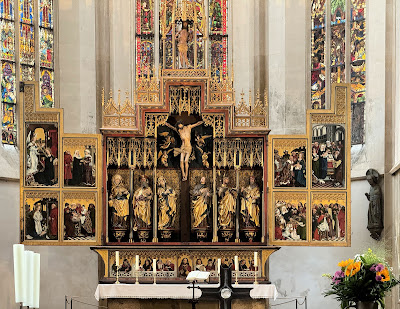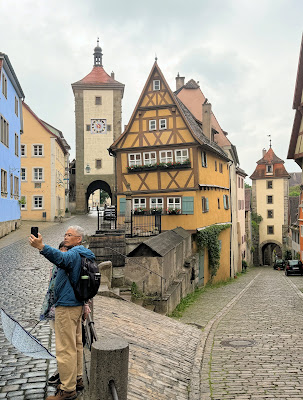There are many Rothenburgs in Germany, but when people say Rothenburg, they
mean the medieval town above the little Tauber River. We entered the city from
the bus parking east, and our guide moved along the Schmiedgasse (blacksmith lane)
toward the center.
We passed the Plönlein with the Kobolzeller Steige, the most photographed object
in Rothenburg.
Suddenly, we turned sharp left and stood before To Hell, a place that
translates to a medieval drinking parlor?

|
Rothenburg is in the background,
while the river's course can only be guessed in the lush flora.
|
We hiked along the
Burggasse (Castel Lane) on the city's western edge and looked into the Tauber valley deep below.

|
Before Rothenburg became a free imperial city under the Habsburgs in
1274,
the hill was crowned by a Staufian castle dating back to 1170.
|
Suddenly, we stood at the town's north gate, where the city guide drew our
attention to a significant opening.
All gates were closed at nightfall to protect the towns against evil intruders. At the time of closing, citizens
outside the city walls got
Torschlusspanik (panicked because the gate was
closing). Latecomers not only had to climb through the small opening in the
gate but also had to pay an obolus. This money hurt the citizens more than the
bending down.

|
|
Tilly (left) watches Mayor Georg Nusch drinking (right) (©Pietro/Wikipedia)
|
Our group was let out on the market square around midday, so I arrived in
time to watch the presentation of the
Meistertrunk (masterful drink)
In 1631, during the Thirty Years War, the commander-in-chief of the
Catholic League, Generalissimo Tilly, besieged the town. Rothenburg
resisted and subsequently was stormed. The inhabitants feared the fate of
Magdeburgum deletum. Indeed, Tilly sentenced the councilors of the Protestant imperial city to death and ordered the place burned and plundered.
Legend has it that in their distress, the councilors offered Tilly wine as
a welcome drink in a splendid, colorful glass that held 3 ¼
liters. This appeased him, and he said that if someone could drink this
tankard of wine in one go, he would spare the town. Former mayor Georg
Nusch volunteered, and, to everyone's amazement, he managed to empty the
glass in one go. Tilly was impressed and kept to his promise.
Following the spectacle, I had the
Rothenburg specialty of a snowball with a coffee in a café.
Strengthened, I traced the scallop shell marking that Rothenburg, like most
towns in Germany, lies on a
Jakobsweg (
Camino de Santiago).

So I arrived at St James' Church, where the saint stood before the
entrance, presenting the scallop shell.
St. James' "free leg" intrigued me, pointing at the bifurcation of the
Jakobsweg to Tübingen /Speyer or Ulm/Konstanz.

|
| Click to enlarge |
The church's interior is dominated by
Friedrich Herlin's Twelve Apostles Altar of 1466,
flanked by scenes from the life of young Jesus.
When I stepped out of the church, it started raining again. So, I took
refuge in the Medieval Museum of Crime.
I visited the place with my family in 1984 on one of our trips from Geneva
to Germany, during which I showed my children historical regions.

|
|
Justice in Olden Times
|
Here is the book I then bought, which is as full of details as the exhibition. I will only present two items from the thousands of objects
shown:

|
| Click to enlarge |
Protocol against Katharina Ranzebach, Martens, after her husband's name, known
as the Martenschene, was heard at the Schöningen office (Brunswick) in
1656.
She was suspected of witchcraft.
Excerpt from her interrogation before the Halsgericht*
*A court that could impose the death penalty (hanging)
"..The devil had come to her in sleep, and if she had not slept, he would have
left her aside, especially since she dreaded him very much and she had crossed
and blessed herself in front of him. He made himself over her in her sleep and
has done shame with her; she could not defend herself, and she had fought for
half a quarter of an hour. He told her she should not bless herself when
he came and that her husband was not at home but herded the oxen in the field
at night. After that, he came to her in the garden, and on top of that, he
told her she should not bless herself; otherwise, he would break her neck. He
had fornicated with her and wore black clothes; his name was Onymus. She had
to tell him that she wanted to do what he wanted, she should not believe in
God, she had to take several steps back and lift her fingers and swear by her
soul that she did not want anything to do with God but give up on him and
believe in him the devil. Then he gave her two pfennig and promised her that
she should have more to come in than from God. Item she admits that he
was in her prison last night and fell on her body, but she blessed herself
with the cross that his shame could not be accomplished. Item she confessed
that he wanted to dampen her with the rope ..."

|
|
Here is an example of corporal punishment of children in the 17th century. Unthinkable today?
|
Later in the afternoon, our group visited rainy Tauberbischofsheim. The city's code of arms with the wheel indicates that it once belonged to the bishopric of Mainz. Large German regions,
including Erfurt, belonged to the Archchancellor of the Holy Roman Empire. The Catholic bishop kept his
Heim (home) on the Tauber River, although he never visited the city.
The day ended with dinner at the Cistercian monastery in Brombach. Cistercians
need a place far from civilization and a valley with a small river to
found their monastery. The Brombach site strangely reminds me of the Cluny Abbey in France.
*
















No comments:
Post a Comment